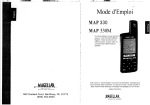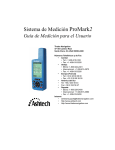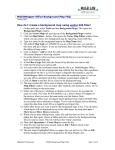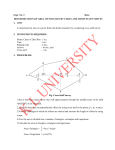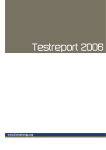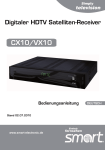Download Magellan 471 El Camino Real Santa Clara, CA. 95050
Transcript
Magellan 471 El Camino Real Santa Clara, CA. 95050-4300 Phone and Fax Numbers • Main • • Voice: +1 408-615-5100 • Fax: +1 408-615-5200 Sales • • US: 800-922-2401 • Fax: 408-615-5200 Europe, Africa, Middle East • • Voice: 44-1753-835-700 • Fax: 44-1753-835-710 South America • • Voice: +56 2 234 56 43 • Fax: +56 2 234 56 47 Support • • • US:1 800-229-2400 Fax: +1 408-615-5200 Int. +1 408-615-3980 Internet • [email protected] • www.magellangps.com • www.ashtech.com Copyright Notice Copyright © 2001 Magellan Corporation. All rights reserved. No part of this publication or the computer programs described in it may be reproduced, translated, stored in a retrieval system, or transmitted in any form or by any means, electronic, mechanical photocopying, recording, or otherwise, without prior written permission of Magellan. Your rights with regard to this publication and the computer programs are subject to the restrictions and limitations imposed by the copyright laws of the United States of America (“U.S.A.”) and/or the jurisdiction in which you are located. For information on translations and distribution outside the U.S.A. please contact Ashtech. Printed in the United States of America. Part Number: 630860-01, Revision A July 2001 Trademark Notice Locus, Z-Xtreme, ProMark2, and Ashtech are trademarks of Magellan Corporation. All other product and brand names are trademarks or registered trademarks of their respective holders. SOFTWARE LICENSE AGREEMENT IMPORTANT: BY OPENING THE SEALED DISK PACKAGE CONTAINING THE SOFTWARE MEDIA OR INSTALLING THE SOFTWARE, YOU ARE AGREEING TO BE BOUND BY THE TERMS AND CONDITIONS OF THE LICENSE AGREEMENT (“AGREEMENT”). THIS AGREEMENT CONSTITUTES THE COMPLETE AGREEMENT BETWEEN YOU ("LICENSEE") AND MAGELLAN (“LICENSOR”). CAREFULLY READ THE AGREEMENT AND IF YOU DO NOT AGREE WITH THE TERMS, RETURN THIS UNOPENED DISK PACKAGE AND THE ACCOMPANYING ITEMS TO THE PLACE WHERE YOU OBTAINED THEM FOR A FULL REFUND. LICENSE. LICENSOR grants to you a limited, non-exclusive, non-transferable, personal license (“License”) to (i) install and operate the copy of the computer program contained in this package (“Program”) in machine acceptable form only on a single computer (one central processing unit and associated monitor and keyboard) and (ii) make one archival copy of the Program for use with the same computer. LICENSOR and its third-party suppliers retain all rights to the Program not expressly granted in this Agreement. ii Promark2 User’s Guide OWNERSHIP OF PROGRAMS AND COPIES. This License is not a sale of the original Program or any copies. LICENSOR and its third-party suppliers retain the ownership of the Program and all copyrights and other proprietary rights therein, and all subsequent copies of the Program made by you, regardless of the form in which the copies may exist. The Program and the accompanying manuals (“Documentation”) are copyrighted works of authorship and contain valuable trade secret and confidential information proprietary to LICENSOR and its third-party suppliers. You agree to exercise reasonable efforts to protect the proprietary interests of LICENSOR and its third-party suppliers in the Program and Documentation and maintain them in strict confidence. USER RESTRICTIONS. The Program is provided for personal use or use in your internal commercial business operations and must remain at all times upon a single computer owned or leased by you. You may physically transfer the Program from one computer to another provided that the Program is operated only on one computer at a time. You may not operate the Program in a timesharing or service bureau operation or rent, lease, sublease, sell, assign, pledge, transfer, transmit electronically or otherwise dispose of the Program or Documentation, on a temporary or permanent basis, without the prior written consent of LICENSOR. You agree not to translate, modify, adapt, disassemble, decompile, or reverse engineer the Program, or create derivative works of the Program or Documentation or any portion thereof. TERMINATION. The License is effective until terminated. The License will terminate without notice from LICENSOR if you fail to comply with any provision of this Agreement. Upon termination, you must cease all use of the Program and Documentation and return them and any copies thereof to LICENSOR. GENERAL. This Agreement shall be governed by and construed in accordance with the Laws of the State of California and the United States without regard to conflict of laws provisions thereof and without regard to the United Nations Convention on Contracts for the International Sale of Goods. Unless modified in writing and signed by both parties, this Agreement is understood to be the complete, exclusive and final agreement between the parties, superseding all prior agreements, oral or written, and all other communications between the parties relating to the Software, Program and Documentation. No employee of Magellan or any other party is authorized to make any agreements in addition to those made in this Agreement. LICENSEE ACKNOWLEDGES THAT IT HAS READ THIS AGREEMENT, UNDERSTANDS IT, AND IS BOUND BY ITS TERMS. iii DISCLAIMER OF WARRANTIES AND LIMITATION OF LIABILITY THIS SOFTWARE, PROGRAM AND DOCUMENTATION IS DISTRIBUTED AND LICENSED "AS IS" AND WITHOUT ANY WARRANTIES, EXPRESS OR IMPLIED, BY LICENSOR AND ITS THIRD-PARTY SUPPLIERS WHO ALSO EXPRESSLY DISCLAIM ANY WARRANTIES OF MERCHANTABILITY, FITNESS FOR A PARTICULAR PURPOSE, PERFORMANCE, FUNCTIONALITY, ACCURACY OF DATA, TITLE OR NONINFRINGEMENT. LICENSOR AND ITS THIRD-PARTY SUPPLIERS DO NOT WARRANT THE SOFTWARE, PROGRAM OR DOCUMENTATION WILL MEET YOUR REQUIREMENTS OR THAT ITS OPERATION WILL BE UNINTERRUPTED, ERROR-FREE, OR VIRUS-FREE. THE USER ASSUMES THE ENTIRE RISK OF USING THIS SOFTWARE, PROGRAM AND DOCUMENTATION. ANY LIABILITY OF LICENSOR, ITS THIRD-PARTY DISTRIBUTORS, OR ANYONE ELSE INVOLVED IN THE CREATION OR DELIVERY OF THE SOFTWARE, PROGRAM OR DOCUMENTATION IS LIMITED TO THE PURCHASE PRICE THEREOF. THERE SHALL BE NO OTHER LIABILITY FOR ANY DIRECT, INDIRECT, INCIDENTAL, CONSEQUENTIAL OR OTHER DAMAGES OF ANY KIND, WHETHER BASED ON BREACH OF WARRANTY, BREACH OF CONTRACT, NEGLIGENCE, STRICT LIABILITY OR ANY OTHER LEGAL THEORY, ARISING OUT OF OR RELATING TO THE USE OR INABILITY TO USE THE SOFTWARE, PROGRAM OR DOCUMENTATION, OR THE PROVISION OF OR FAILURE TO PROVIDE SUPPORT SERVICES, EVEN IF LICENSOR HAS BEEN ADVISED OF THE POSSIBILITY OF SUCH DAMAGES. U.S. GOVERNMENT RESTRICTED RIGHTS The Software, Program and Documentation are provided with RESTRICTIVE RIGHTS. Use, duplication, or disclosure by or on behalf of the United States government is subject to restrictions as set forth in subdivision (c)(1)(ii) of the Rights in Technical Data and Computer Software clause at DFARS 252.227-7013 or subdivision 9(C)(1) and (2) of the Commercial Computer Software-Restricted Rights 48 CFR 52.227.19, as applicable. Should you have any questions concerning this Disclaimer of Warranties and Limitation of Liability, please contact in writing: Magellan Corporation, Legal Department, 471 El Camino Real, Santa Clara, CA 95050, USA. iv Promark2 User’s Guide MANUAL DISCLAIMER. THIS MANUAL IS PROVIDED “AS IS”; MAGELLAN MAKES NO WARRANTIES TO ANY PERSON OR ENTITY WITH RESPECT TO THE SUBJECT MATTER, CONTENTS OR USE OF INFORMATION CONTAINED HEREIN OR ANY DERIVATIVES THEREOF. MAGELLAN DISCLAIMS ALL IMPLIED WARRANTIES, INCLUDING, WITHOUT LIMITATION, WARRANTIES OF MERCHANTABILITY AND FITNESS FOR A PARTICULAR PURPOSE, NONINFRINGEMENT, AND TITLE. FURTHER, MAGELLAN DOES NOT WARRANT, GUARANTEE, OR MAKE ANY REPRESENTATIONS REGARDING THE USE, OR THE RESULTS OF THE USE, OF THIS MANUAL IN TERMS OF CORRECTNESS, ACCURACY, RELIABILITY, OR OTHERWISE. THIS PUBLICATION AND FEATURES DESCRIBED HEREIN ARE SUBJECT TO CHANGE WITHOUT NOTICE. v vi Promark2 User’s Guide Chapter 1 Introduction ...........................................................................1 What is the ProMark2 Survey System? ............................................................................. 1 Items Supplied with ProMark2 .......................................................................................... 2 ProMark2 GPS Receiver .............................................................................................. 2 External GPS Antenna ................................................................................................. 3 External Antenna Cable ............................................................................................... 3 Vertical Antenna Extension ......................................................................................... 4 Field Receiver Bracket ................................................................................................. 4 HI (Height of Instrument) Measurement Tape ............................................................. 5 Field Bag ...................................................................................................................... 5 Office Receiver Bracket with Download Cable ........................................................... 6 MapSend Streets CD .................................................................................................... 6 Ashtech Solutions Post-Processing Software ............................................................... 7 Documentation ............................................................................................................. 8 Additional Items Required but not Supplied ...................................................................... 9 Tripod, Tribrach, and Tribrach Adapter ....................................................................... 9 Fixed-Height GPS Tripod .......................................................................................... 11 Specifications ................................................................................................................... 12 Surveying with ProMark2 ................................................................................................ 13 Navigating with ProMark2 ............................................................................................... 13 Time in the Field .............................................................................................................. 14 Where to Find Information .............................................................................................. 14 Technical Support ............................................................................................................ 15 Chapter 2 Getting Started .....................................................................17 Overview .......................................................................................................................... 17 Control Buttons ................................................................................................................ 17 Battery Life ...................................................................................................................... 19 Installing Batteries ........................................................................................................... 22 Memory Management ...................................................................................................... 22 Initialization for First-Time Use ...................................................................................... 23 Downloading Collected Data to Office Computer ........................................................... 24 Chapter 3 Surveying with the ProMark2 System ...............................25 Survey Planning ............................................................................................................... 25 Network Design .......................................................................................................... 25 Observation Plan ........................................................................................................ 28 Performing a Static Survey with the ProMark2 ............................................................... 33 Equipment Check ....................................................................................................... 33 Site Selection .............................................................................................................. 33 vii System Setup ...............................................................................................................35 Data Collection ...........................................................................................................39 Chapter 4 Detailed Screen Descriptions .............................................. 53 Mode Screen .....................................................................................................................54 Survey Screen ...................................................................................................................55 Survey Menu Screen .........................................................................................................57 Point Attribute Screen ......................................................................................................58 File Manager Screen .........................................................................................................60 Unit of Measure Screen ...................................................................................................62 Receiver ID Screen ...........................................................................................................63 Contrast Screen .................................................................................................................64 Satellite Status Screen ......................................................................................................64 Survey Status Screen ........................................................................................................66 Edit Screens ...................................................................................................................... 68 Alarm Screens ...................................................................................................................69 No External Antenna ..................................................................................................69 Low Battery ................................................................................................................69 Extreme Low Power ...................................................................................................70 Low Memory ..............................................................................................................70 Power Down Screen ........................................................................................................70 viii Promark2 User’s Guide Figure 1.1 Figure 1.2 Figure 1.3 Figure 1.4 Figure 1.5 Figure 1.6 Figure 1.7 Figure 1.8 Figure 1.9 Figure 1.10 Figure 1.11 Figure 1.12 Figure 1.13 Figure 1.14 Figure 1.15 Figure 2.1 Figure 2.2 Figure 2.3 Figure 2.4 Figure 2.5 Figure 2.6 Figure 3.1 Figure 3.2 Figure 3.3 Figure 3.4 Figure 3.5 Figure 3.6 Figure 3.7 Figure 3.8 Figure 3.9 Figure 3.10 Figure 3.11 Figure 3.12 Figure 3.13 Figure 3.14 Figure 3.15 Figure 3.16 Figure 3.17 Figure 3.18 Figure 3.19 ProMark2 Two-Receiver System ................................................................. 1 ProMark2 GPS Receiver .............................................................................. 2 External GPS Antenna ................................................................................. 3 External Antenna Cable ............................................................................... 3 Vertical Antenna Extension ......................................................................... 4 Field Receiver Bracket ................................................................................. 4 HI Measurement Tape .................................................................................. 5 Field Bag ...................................................................................................... 5 Office Receiver Bracket with Download Cable ........................................... 6 MapSend Streets CD ................................................................................... 7 Ashtech Solutions Software ......................................................................... 8 Tripod, Tribrach, and Tribrach Adapter....................................................... 9 Tribrach and Tribrach Adapter................................................................... 10 Tribrach Adapter Mounted to Tribrach ...................................................... 10 Fixed-Height GPS Tripod with Extender and GPS Antenna ..................... 11 Control Buttons used for Survey Functions ............................................... 17 Battery Life vs Temperature ...................................................................... 19 Low Battery Alarm..................................................................................... 20 Extreme Low Power Alarm........................................................................ 21 Battery Installation ..................................................................................... 22 Office Bracket with Download Cable ........................................................ 24 Three-point Control Survey Example ........................................................ 26 Closed-Loop Traverse Design.................................................................... 26 15-Point Control Survey Example ............................................................. 27 Network Design for 15-Point Control Survey............................................ 27 Closed-Loop Traverse of 3-Point Control Survey ..................................... 28 Network Design for 3-Point Control Survey.............................................. 29 Network Design for 15-Point Control Survey............................................ 30 Receiver Observation Plan for 15-Point Control Survey ........................... 31 GPS Antenna, Vertical Extension Bar, Tribrach Adapter Assembly......... 35 GPS Antenna Mounted on Tripod using Tribrach and Extender ............... 36 Mounting ProMark2 into Field Bracket Cradle ......................................... 36 Field Bracket on Tripod ............................................................................. 37 Antenna Cable Connection at the Antenna and Receiver .......................... 38 Measuring HI (Height of Instrument) ........................................................ 39 Mode Screen............................................................................................... 40 Survey Screen............................................................................................. 41 Survey Menu .............................................................................................. 42 Point Attribute Screen ................................................................................ 43 File Manager Screen................................................................................... 44 ix Figure 3.20 Figure 3.21 Figure 3.22 Figure 3.23 Figure 3.24 Figure 3.25 Figure 4.1: Figure 4.1 Figure 4.2 Figure 4.3 Figure 4.4 Figure 4.5 Figure 4.6 Figure 4.7 Figure 4.8 Figure 4.9 Figure 4.10 Figure 4.11 Figure 4.12 Figure 4.13 Figure 4.14 Figure 4.15 x Unit of Measure Screen ............................................................................. 45 Receiver ID Screen .................................................................................... 46 Contrast Screen .......................................................................................... 47 Survey Screen ............................................................................................ 48 Satellite Status Screen................................................................................ 49 Survey Status Screen.................................................................................. 50 Screen Map ................................................................................................ 53 Promark 2 Opening Screen ........................................................................ 54 Mode Screen .............................................................................................. 54 Survey Screen ............................................................................................ 55 Survey Menu Screen .................................................................................. 57 Point Attribute Screen................................................................................ 58 File Manager Screen .................................................................................. 60 File Naming Convention for Survey Data Files ........................................ 61 Unit of Measure Screen ............................................................................. 62 Receiver ID Screen .................................................................................... 63 Contrast Screen .......................................................................................... 64 Satellite Status Screen................................................................................ 65 Survey Status Screen.................................................................................. 66 Edit Screens - Site ID, Site Descriptor, Receiver ID. ................................ 68 Alarm Screens - Antenna, Battery, Power, Memory ................................ 69 Power Down Screen................................................................................... 70 Promark2 User’s Guide Table 1.1 Table 2.1 Table 4.1 Table 4.2 Table 4.3 Table 4.4 Table 4.5 Table 4.6 Table 4.7 Table 4.8 Table 4.9 Performance and Physical Specifications ....................................................... 12 Control Buttons used for Survey Functions.................................................... 18 Mode Screen Selections .................................................................................. 55 Survey Screen Selections ................................................................................ 55 Survey Menu Screen Selections...................................................................... 57 Point Attribute Screen Parameters .................................................................. 58 File Manager Screen Parameters..................................................................... 60 Unit of Measure Screen Parameters................................................................ 62 Receiver ID Screen Parameters....................................................................... 63 Satellite Status Screen Parameters .................................................................. 65 Survey Status Selections ................................................................................. 66 xi xii Introduction What is the ProMark Survey System? Promark2 is a complete GPS system providing both navigation and precision surveying. The ProMark2 system, Figure 1.1, includes two or more ProMark2 GPS receiver, GPS antennas, and all ancillary components required to get you up and running and producing quality survey data in a minimum amount of time. Figure 1.1 ProMark2 Two-Receiver System The ProMark2 system utilizes standard tripods or fixed-height GPS tripods to position system components above a given survey point. The ProMark2 receiver collects signals broadcast from GPS satellites, and stores this information in its internal solid-state memory. The collected data is extracted from the ProMark2 receiver via a serial data cable to an office computer for post-processing. Introduction 1 The ProMark2 System operates in conjunction with Ashtech Solutions, Ashtech’s highlyautomated GPS post-processing engine. Ashtech Solutions is a complete, easy-to-use software package which manages and processes raw GPS data, deriving precise positioning data and presenting the results in easily understood report formats. Items Supplied with ProMark2 The items supplied with ProMark2 are described in the following paragraphs. ProMark2 GPS Receiver The ProMark2 GPS receiver, Figure 1.2, acquires and stores raw GPS satellite data at each survey point. The data from each ProMark2 is later post-processed to determine the relative position of the points surveyed. Figure 1.2 ProMark2 GPS Receiver 2 Promark2 User’s Guide External GPS Antenna Figure 1.3 External GPS Antenna External Antenna Cable The external antenna cable, Figure 1.4, connects the ProMark2 receiver to the external antenna. The small end of the cable connects to the ProMark2 through the back of the field receiver bracket. The large end of the cable screws onto the external antenna. Figure 1.4 External Antenna Cable Introduction 3 Introduction The external GPS antenna, Figure 1.3, is required for surveying functions. While the built-in antenna is sufficient for navigation, a more sophisticated external antenna is required to obtain quality data for precision surveying. The external GPS antenna is the physical data collection point for the raw GPS satellite data. For this reason, it must be accurately positioned over the point to be surveyed, using a standard tripod or fixed-height GPS tripod. Vertical Antenna Extension The vertical antenna extension, Figure 1.5, provides clearance for the antenna cable when the antenna is mounted on a tripod. Figure 1.5 Vertical Antenna Extension Field Receiver Bracket The field receiver bracket, Figure 1.6, serves a number of functions. First, it provides the means for mounting the ProMark2 GPS receiver to the tripod. Second, it lends support for the external GPS antenna cable connection to the back of the ProMark2 receiver. Finally, it provides the interface for connection of the external power pack to the ProMark2 receiver. Figure 1.6 Field Receiver Bracket 4 Promark2 User’s Guide HI (Height of Instrument) Measurement Tape Figure 1.7 HI Measurement Tape Field Bag The field bag, Figure 1.8, is used to transport the components of each ProMark2 GPS receiver system between the office and the field. Figure 1.8 Field Bag Introduction 5 Introduction The HI measurement tape, Figure 1.7, is used to measure height of the GPS antenna over the survey point. The end of the tape hooks onto the antenna. The tape is extended until the spike on the tape case is on the point. Then the height of the antenna is noted on the tape. Office Receiver Bracket with Download Cable The office receiver bracket with integrated download cable, Figure 1.9, is an interface device that connects the ProMark2 receiver to an office computer for downloading of stored GPS satellite data. When the ProMark2 is placed into the bracket, the download cable is automatically connected to the receiver via the contacts on the back of the receiver. Office Bracket with Download Cable Contacts on back of receiver Figure 1.9 Office Receiver Bracket with Download Cable MapSend Streets CD The MapSend Streets CD, Figure 1.10, contains detailed street-level maps that can be loaded into the internal memory of the ProMark2 receiver. These detailed maps can then be used with the navigation functions of the receiver to assist in navigating to the job site. Be aware that the maps and the raw GPS satellite data occupy the same internal 8 megabytes of memory, thus the larger map you load, the less survey data you can store. The MapSend CD covers only certain geographical areas. It is not included with ProMark2 Survey Systems sold outside of these areas. 6 Promark2 User’s Guide Introduction Figure 1.10 MapSend Streets CD Ashtech Solutions Post-Processing Software The Ashtech Solutions post-processing software, Figure 1.11, provides the tools required to download and process the GPS satellite data from each ProMark2 receiver to produce relative positions of all points surveyed. Ashtech Solutions is provided on a CD and is accompanied by a user’s guide. Introduction 7 Figure 1.11 Ashtech Solutions Software Documentation The following documentation items are supplied with ProMark2: • • • • 8 ProMark2 Survey System User’s Guide for Survey - Instructions on using ProMark2 for surveying ProMark2 User’s Guide for Navigation - Instructions on using ProMark2 for navigation. This manual may be included with your system as the MAP330 User Manual. Quick Reference Card - Condensed summary of survey functions on card which can be carried into the field. Ashtech Solutions User’s Guide - Instructions on using the Ashtech Solutions office software for mission planning, downloading, and post-processing data Promark2 User’s Guide Additional Items Required but not Supplied Introduction In order to conduct your survey, you will need some of the additional equipment discussed below. This equipment is not supplied with the standard ProMark2 survey system. Tripod, Tribrach, and Tribrach Adapter For each ProMark2 receiver in your system, you will need a tripod, tribrach, and tribrach adapter, Figure 1.12, Figure 1.13, and Figure 1.14, to position the GPS antenna over the survey point. The tribrach provides an optical sight and leveling adjustments that facilitate accurately positioning the antenna over the survey point. The tribrach adapter slides into the tribrach, providing the interface to the GPS antenna. Figure 1.12 Tripod, Tribrach, and Tribrach Adapter Introduction 9 Antenna adapter 5/8 x 11 UNC thread Levelling bubble Lock for antenna adapter Tribrach adapter Levelling screw Tribrach Optical sight Figure 1.13 Tribrach and Tribrach Adapter Locking tab Figure 1.14 Tribrach Adapter Mounted to Tribrach 10 Promark2 User’s Guide Fixed-Height GPS Tripod Introduction An option to the tripod, tribrach, and tribrach adapter combination is the fixed-height GPS tripod, Figure 1.15. The fixed-height GPS tripod has the advantage of eliminating the possibility of measuring and/or recording an incorrect HI, since the height is fixed. HI blunders are one of the most common mistakes during data collection. Figure 1.15 Fixed-Height GPS Tripod with Extender and GPS Antenna Introduction 11 Specifications Table 1.1 lists performance and physical specifications for the ProMark2 system. Table 1.1 Performance and Physical Specifications Parameter Specification GPS survey mode supported Static Survey accuracy (RMS) Horizontal: 0.005 m + 1 ppm Vertical: 0.010 m + 2 ppm Navigation accuracy (RMS) <3 m with external antenna (with WAAS) 5 m with internal antenna (with WAAS) Survey point spacing (vector length) Up to 20 kilometers Over 20 kilometers possible during periods on low ionospheric activity Observation time 20 to 60 minutes typical, depending upon vector length GPS satellite channels 10 WAAS/EGNOS satellite channels 2 GPS satellite elevation mask 10 degrees Recording interval 10 seconds Operating temperature range -10 to + 60 degrees C Battery type 2 AA, alkaline or lithium Battery life Internal (2 AA): Up to 8 hours with alkaline @ 20 °C Up to 13 hours with lithium @ 20 °C External + internal (6 AA): Up to 24 hours with alkaline @ 20 °C Up to 39 hours with lithium @ 20 °C See Battery Life on page 19 for details. Data storage memory capacity 8 megabytes 72 hours of survey data 100 data files See Memory Management on page 22 for details Note: Below -10°C, the ProMark2 screen will eventually become blank. Although the screen is blank, the receiver is still operating normally, collecting survey data. Prolonged exposure to temperatures below -20 °C could result in damage to the ProMark2 screen. 12 Promark2 User’s Guide Surveying with ProMark2 The static data collection method produces the most accurate and reliable results of any mode of GPS data collection. This is due primarily to the extended observation periods required for static data collection. Navigating with ProMark2 The ProMark2 includes a wide range of navigational capabilities that you will find useful in your day-to-day surveying operations. Two useful navigation features are: • • The street database and map screen can be utilized to help you find a project site. This feature is only available to users within the continental US. The ProMark2 serves as an excellent reconnaissance tool. You can enter the known coordinates of the feature you wish to recon as a waypoint, and use ProMark2 to navigate to within 3 meters (9 feet) of the feature in the field. Be sure to select the correct map datum and coordinate system (use the user-defined feature to define State Plane grid zones). ProMark2 includes the capability to utilize the Wide Area Augmentation System (WAAS) and the European Geostationary Navigation Overlay System (EGNOS) to provide improved positioning accuracy. These systems calculate errors in the GPS signal, then transmit correction messages to capable GPS receivers. Typical accuracy with WAAS augmentation is three meters, although this accuracy can be degraded by multipath reflections and poor satellite geometry. More information on WAAS is available at the FAA web site http://gps.faa.gov/ Programs/WAAS/waas.htm. More information on EGNOS is available at http://www.esa.int/ EGNOS/. Introduction 13 Introduction The ProMark2 system is designed to perform GPS surveys using the static mode of GPS data collection. In the static data collection mode, the GPS receiver systems simultaneously collect raw data from all available satellites while remaining stationary on their respective points. Data collection continues at these locations for a duration dependent upon the distance between the receivers, the satellite geometry, and the obstruction conditions at the data collection locations (i.e., trees or buildings blocking some of the sky). When data collection is complete at these specific points, you move the GPS receiver systems to a new set of points to begin another data collection session. In most cases, one GPS receiver system will remain on its current point (pivot point) in order to link the previous set of points to the new set of points, in leap-frog fashion. After data collection is complete, data is downloaded from the GPS receivers to an office computer for post-processing using the Ashtech Solutions software. The post-processing activity computes vectors (position differences) to determine the position of all observed points relative to one or more fixed point positions. For details on how to utilize your ProMark2 receiver for navigation, refer to the ProMark2 Survey System User’s Guide for Navigation or the MAP330 User Manual. Time in the Field In general, the amount of time required to occupy a point depends on several factors: 1. Distance between survey points. In general, the greater this distance, the longer the observation time. 2. Environmental conditions, or the amount of obstruction or canopy preventing a completely open sky view. Some obstructions may block the reception of the satellite signal, requiring longer observation times to collect additional data for accurate processing. Too much obstruction prevents ProMark2 (or any GPS receiver) from receiving enough data to establish quality survey positions. 3. Satellite Geometry: This refers to the position of the satellites that are orbiting the earth. If the satellites are positioned poorly (i.e. all on one side of the sky), it is more difficult to get an accurate position. The Mission Planning Tool in Ashtech Solutions assists in planning survey times with optimal geometry. You will find that observation times will vary between 20 and 60 minutes depending upon factors 1, 2, and 3 above. The Observation Timer feature of ProMark2 is designed to assist in determining observation times. The Observation Timer takes into consideration the number of satellites and satellite geometry, and determines when enough data has been collected for a given distance between points. For more information on the observation timer, please refer to page 32. Where to Find Information This manual is designed to guide you through the ProMark2 survey procedures as well as provide general reference. You can find additional information in the following documents: • 14 ProMark2 User’s Guide for Navigation: This manual is supplied with your ProMark2 system, and provides detailed instructions for using the ProMark2 Promark2 User’s Guide navigation functions. In your particular system, you may find this book entitled MAP330 User Manual. • Introduction Ashtech Solutions Manual: This manual provides detailed instructions for postprocessing and presenting the data collected by ProMark2. Technical Support Magellan Corporation is committed to providing top technical support and service to our customers worldwide. You can contact Magellan as follows. • The Front Line: Contact directly at 1-800-229-2400 or 408-615-3980 between 7AM-6PM PST for prompt, professional service. This number connects you to an Automatic Call Distribution (ACD) system which feeds into the technical support group. • The Internet. Access the Ashtech Precision Products website at www.ashtech.com or magellangps.com. • Email. Email contact is [email protected]. • Global Dealer Network. Ashtech Precision Products dealers throughout the world are available to assist you. Contact the corporate office in Santa Clara California for the name of the dealer nearest you. Introduction 15 16 Getting Started Overview This chapter discusses the basic features and operation of ProMark2. This is followed by a quick tour of the survey interface to show how ProMark2 can be used to collect survey data with accompanying point attribute data. Control Buttons Figure 2.1 shows the control buttons used for survey functions. Table 2.1 describes the function of each button. Selects item on screen Cancels last operation, scrolls screens Accesses and toggles screens Confirms data entry or menu selection Accesses menus and other functions Turns unit on or off Figure 2.1 Control Buttons used for Survey Functions Getting Started 17 Table 2.1 Control Buttons used for Survey Functions Button 18 Description ENTER The ENTER button is used to either execute the highlighted function, edit the highlighted parameter, or enter the highlighted value. To illustrate, refer to Figure 4.4 on page 57, which shows the Survey Menu screen. The Point Attribute function has been highlighted by using the up/down arrows. To execute the Point Attribute function, press the ENTER button. Another example, Figure 4.5 on page 58, shows the Point Attribute screen. The Site ID parameter is highlighted. Press the ENTER button to edit the site ID. Another instance is Figure 4.13 on page 68, which shows the edit screen for entry of the site ID. To enter a value, i.e. the number 1, press the ENTER button when the value is highlighted. MENU The MENU button serves one purpose which is to access the Survey Menu screen, page 57, at any time during survey data collection. Red power button The power button (red with a picture of a light bulb) serves two purposes: When pressed and released quickly, it turns the receiver on and off. When pressed and held for 2 seconds while the receiver is on, it turns on the screen backlight at the low setting. If pressed and held again for 2 seconds, it sets the backlight to high. Finally, press and hold the button again for 2 seconds to turn off the backlight. MARK/GOTO The MARK/GOTO button serves one purpose which is to access the Point Attribute screen, page 58, at any time during survey data collection. NAV/SURV The NAV/SURV button has one purpose which is to toggle between the Satellite Status screen (page 65) and Survey Status screen (page 66) at any time during data collection. ESC The ESC button is used to close a screen, reverting back to the previous screen. In most cases, any editing of parameters in the screen will not be saved. Oval button with four arrows The oval shaped arrows button is used to highlight the function you wish to execute or highlight the value you wish to enter. This is illustrated in the Mode screen in Figure 4.2 on page 54, which lets you operate either in Survey mode or Navigate mode. In this screen, the up/down arrows allow you to toggle between Survey or Navigate. In Figure 4.13 on page 68, you see the edit screen for entry of a point description. By using the up/down and left/right arrows, you can highlight either a value to enter, i.e. the number 1, or you can highlight a function to execute, i.e. OK Promark2 User’s Guide Battery Life Alkaline Battery Life (2 AA Energizer batteries) 12 Discharge Time (Hrs) 11 10 9 8 7 6 5 4 3 2 1 -10 0 +10 +20 +30 +40 +50 +60 Discharge Temperature (degrees C) Lithium Battery Life (2 AA Energizer batteries) 16 Discharge Time (Hrs) 15 14 13 12 11 10 9 8 7 6 5 4 3 2 1 -10 0 +10 +20 +30 +40 +50 +60 Discharge Temperature (degrees C) Figure 2.2 Battery Life vs Temperature As is evident from the graph of the alkaline batteries, temperature plays a large part in the operational life. This is true for all battery types with the exception of lithiums. The lithium experiences little effect on operational life due to temperature, making lithium the best choice for low temperature operation. Getting Started 19 Getting Started The ProMark2 receiver is conveniently powered by 2 standard AA batteries. Any battery type in the AA form factor can be used in the ProMark2 receiver, including both disposables (alkaline, lithium) and rechargeables (nickel-cadmium, nickel-metal-hydride, alkaline). Lithiums will run the ProMark2 for the longest period of time, followed by alkalines, rechargeable alkalines, rechargeable nickel-metal-hydrides, and finally nickel-cadmiums. Figure 2.2 shows the ProMark2 battery life vs temperature for a set of 2 alkaline and a set of 2 lithium batteries. These graphs were produced from test results using the Energizer brand of batteries. The ProMark2 receiver monitors the status of the battery life during receiver operation. This is accomplished by monitoring the remaining voltage of the batteries as they are discharged. The ProMark2 receiver displays battery alarms when the remaining battery life gets low. The first alarm is the Low Battery alarm, Figure 2.3. Remaining operational time after the appearance of this alarm is very dependent on battery type used and the temperature at which the receiver is being operated. You can expect approximately 1 hour of life remaining at room temperature with standard alkaline batteries. The remaining life will be shorter at lower temperatures. At 10°C, the remaining life could be as low as 10 minutes. Figure 2.3 Low Battery Alarm 20 Promark2 User’s Guide The final battery alarm is the Extreme Low Power alarm, Figure 2.4. When this alarm appears, the active survey data file is closed and the receiver is shut down after 10 seconds. The current batteries will need to be replaced in order to continue with the survey Getting Started Figure 2.4 Extreme Low Power Alarm Getting Started 21 Installing Batteries To install batteries, remove the battery compartment cover as shown in Figure 2.5. Remove old batteries, if any, and install new batteries, observing polarity as indicated. Replace cover and tighten retaining screw. - + Turn screw counterclockwise to remove battery compartment cover Removing cover + Battery polarity Figure 2.5 Battery Installation Memory Management The ProMark2 receiver includes 8 megabytes of memory available for data storage. Within these 8 megabytes, a minimum of 72 hours of observation time can be stored under the worstcase condition where 10 satellites are being tracked continuously. Below are some tips on managing the data storage memory of the ProMark2 to minimize the chances of losing data or running out of memory during data collection. Note: The 72-hour duration is possible only if the entire 8 megabytes is used for data. If maps are loaded, the duration will be less. 1. 22 Download collected data daily. Downloading and processing your data daily will reduce the chances of losing data by accidental deletion. Promark2 User’s Guide Delete data from receiver after processing. Keep the data files in the receiver until after you have completed the processing. If a data file were corrupted during download, this procedure will provide you with the opportunity to download the file once again. 3. Beware of large detailed street-level map files. The MapSend Streets CD included with your package (US customers only) includes detailed street-level maps which can be downloaded into the ProMark2 receiver. These detailed map files share memory space with the survey data files. All 8 megabytes of data storage memory can be used to store survey data if no detailed maps have been loaded into the receiver. If a 3-megabyte detailed map has been loaded, only 5 megabytes remain for survey data storage. As a safeguard, the ProMark2 will not allow you to utilize more than 4 megabytes of data storage memory for detailed street maps. This ensures that there will always be at least 4 megabytes of memory available for survey data storage. Initialization for First-Time Use When turned on for the first time, the ProMark2 must be initialized. The reason for initialization is to speed up the process for computing the first position fix when the ProMark2 has no last position in memory (i.e. when the ProMark2 is brand new or memory has been cleared). To initialize the ProMark2, turn on the receiver. You will be presented with the Opening Screen, Figure 4.1, page 54. Press ENTER until you are prompted to supply the receiver with your current location, time, and date. When you have finished entering this information, select Done and turn off the ProMark2 receiver. You are now initialized. For more details on the initialization process, see the section titled 'Initialization for First Time Use' in the ProMark2 User's Guide for Navigation or the MAP330 User Manual. Getting Started 23 Getting Started 2. Downloading Collected Data to Office Computer After you have collected data in the field, you must download the data to an office computer and process the data using the Ashtech Solutions software. Use the following procedure to download the receiver data. 1. Insert the ProMark2 receiver into the office bracket, Figure 2.6, making sure that the ProMark2 is securely retained by the hook on the bracket. Figure 2.6 Office Bracket with Download Cable 24 2. Connect the download cable to one of the COM ports on the office computer. COM1 is the recommended port. 3. Turn on the ProMark2. The opening screen appears momentarily, followed by the Mode screen. 4. To download the data from the ProMark2 receiver to the office computer, follow the procedure outlined in Chapter 4 of the Ashtech Solutions User’s Guide under the heading “Adding Data from Receiver.” When configuring communication settings, set baud rate to 115200. Leave other parameters set to default values. Promark2 User’s Guide This chapter presents step-by-step procedures for performing a GPS survey with the ProMark2 system. Review this chapter thoroughly before attempting to perform your first survey. As an exercise, take your system outside of your office and perform a sample survey following the procedures outlined below. Then download and process the collected data with Ashtech Solutions. After this exercise, you will be ready to perform your first real survey with the ProMark2 system. Survey Planning Network Design You have identified a survey for which you wish to use the ProMark2 system to establish control. Regardless if the number of control points to be established is 2 or 20, you must design a network defining the number and location of observations (vectors in our case) that will be required to effectively position the new points. As an illustration, consider an example where two new intervisible points are to be established on a project site for use as control for a boundary survey. The two new points need to be tied Surveying with the ProMark2 System 25 Surveying with the Prior to venturing out into the field, you must first plan how you will execute your GPS survey. Proper planning will greatly increase the chances of success. There are two primary areas of survey planning, the network design and observation plan. Each is discussed below. to an existing control point 3 kilometers (1.9 miles) away, Figure 3.1. Figure 3.1 Three-point Control Survey Example If you were to perform this survey with a conventional total station, you would probably plan on running a closed-loop traverse from the existing control point through the two new points, Figure 3.2. The same philosophy can be used for GPS surveys. Figure 3.2 is your network design for this survey. Figure 3.2 Closed-Loop Traverse Design The previous example resulted in a very simple network design. Figure 3.3 represents a a more complex control survey where 10 new points are to be established based on 2 existing 26 Promark2 User’s Guide horizontal and 3 existing vertical control points. Again, if you were to perform this survey with a conventional total station, you would design a traverse plan which produced a strong looking network of closed-loop traverses through the points of the survey. Figure 3.4 shows one possible network design. Figure 3.4 Network Design for 15-Point Control Survey Surveying with the ProMark2 System 27 Surveying with the ProMark2 System Figure 3.3 15-Point Control Survey Example Although the network design in Figure 3.4 was produced with conventional traversing in mind, this same design can also be used if performing the survey with GPS equipment. When designing your network, keep the following principles in mind: • Design loops through the network points which resemble a square or circle. Avoid loops that are long and skinny. Circular or square shaped loops are stronger geometrically. • Keep the number of points in each loop fewer than 10. • Always include a direct link between intervisible points, i.e. points which may be used as a pair for orientation of a conventional traverse. Since, in most instances, intervisible points are relatively close to each other, it is important to get a direct observation between them. Observation Plan With the network design completed, the next step is to determine how and when data collection while be performed to produce the desired network. First let’s discuss the how. If you were to use a conventional total station to perform the survey in Figure 3.2, your resulting traverse could probably look something like Figure 3.5. Figure 3.5 Closed-Loop Traverse of 3-Point Control Survey The number of traverse legs required to traverse between each point in the network will depend upon the conditions on the ground between the points. If you are in luck, the area is relatively flat and there is a straight road running from the existing control point to the two new points to be established, thus minimizing the number of legs required to complete the loop. Surveying with GPS has the advantage of not requiring line-of-sight between the points surveyed. This allows for direct observations between the points. To illustrate this, let’s take 28 Promark2 User’s Guide our 3-point control survey network design, shown again in Figure 3.6. 2 3 1 Assume that a 2-receiver ProMark2 system will be used to perform the survey in Figure 3.6. To produce the link between the existing control point 1 and the new point 2, simply place one ProMark2 receiver system on point 1, place the other receiver on point 2 and simultaneously collect data between the two points. When the observation is complete, move the ProMark2 receiver from point 2 to point 3. Perform another observation, simultaneously collecting data on points 1 and 3. When completed, move the ProMark2 receiver from point 1 to point 2. Perform the final observation between points 3 and 2. When this data is downloaded and processed, the result will be three vectors (delta positions) forming the network design seen in Figure 3.6. Now consider the situation where a 3-receiver ProMark2 system is used. By placing one receiver on each of the 3 points in the network of Figure 3.6, the data for all three vectors can be collected in one observation, rather than the 3 separate observations required with using a 2receiver system. Now consider the observation plan for the more complex 15-point survey, shown again in Figure 3.7. Surveying with the ProMark2 System 29 Surveying with the ProMark2 System Figure 3.6 Network Design for 3-Point Control Survey 12 11 5 6 4 10 3 13 9 14 2 8 1 7 15 Figure 3.7 Network Design for 15-Point Control Survey To execute this network design, you must perform a direct GPS observation between all points directly linked. Each link can be viewed as a required GPS vector. Counting the links in this network design, you will find that 19 GPS vectors are required to execute this design. If the survey was to be performed using a 2-receiver ProMark2 system, 19 separate data collection sessions (observations) would be required. For example, you can start with a receiver on point 1 and another on point 2. After this observation, you would move the receiver from point 1 to point 3 to perform an observation between points 2 and 3, and so on until all vectors were observed. Now consider the situation where the survey in Figure 3.7 is to be performed using a 3-receiver ProMark2 system. With 3 receivers, each observation session will produce 2 vectors from the network design. For example, you may start by placing one receiver on point 1, the second on point 2, and the third on point 7. These three receivers would simultaneously collect data on these three points, resulting in the vectors between points 1 and 2, and points 1 and 7. In addition to these two vectors, a third vector is produced between points 2 and 7. At the end of this first observation, you could move the receiver from point 2 to point 9 and the receiver from point 1 to point 8. The receiver at point 7 would remain as the pivot point, connecting the first observation to the second. This would continue until all vectors were observed. Figure 3.8 shows what the observation plan might look like with a 3-receiver ProMark2 system. 30 Promark2 User’s Guide 6 5 7 4 9 8 3 1 2 10 The observation plan shows that it will take 10 separate observation sessions to complete the survey based on the network design in Figure 3.7. Notice that all observation sessions, except for session 6, produce 2 vectors required from the network design. Observation 6 produces only one since there were an odd number of required vectors (19). This completes the discussion on how to execute the observation plan. The next question to answer is when do we perform the observations. The best time to perform GPS surveys is determined by an examination of the GPS satellite constellation at your location for a given time of day. The number of visible GPS satellites and the distribution of the satellites in the sky are important factors impacting the observation time required to produce quality GPS vectors. Times when the number of visible GPS satellites is low or the satellite distribution is poor will require extended data collection periods to ensure quality results. In rare instances, availability and distribution may be so poor that you are better off not performing your survey during these periods. Included in the Ashtech Solutions processing software package is a module called Mission Planning. The Mission Planning software provides you with the tools to examine the GPS satellite constellation. Using satellite almanac information, which predicts the location of the GPS satellites into the future, you can examine satellite availability and distribution for the day(s) when you wish to perform your survey to isolate any time periods were observation times may need to be extended or periods where it is best not to collect data. You provide the software with your current location and the date when you wish to perform your survey. The software then provides you with multiple ways of examining the satellite constellation at your Surveying with the ProMark2 System 31 Surveying with the ProMark2 System Figure 3.8 Receiver Observation Plan for 15-Point Control Survey location for the given time. Pay particular attention to satellite availability (number of satellites in view) and the satellite distribution. To assist in analyzing the quality of satellite distribution, Dilution of Precision (DOP) values are presented. DOP is a quality analysis value for satellite distribution. The most popular DOP value is PDOP, which stands for Positional Dilution of Precision. The PDOP value estimates the impact on the precision of your GPS observations due to satellite geometry. The smaller the PDOP value the better the satellite distribution (geometry) and therefore the better the precision of your observations. The manual and on-line help for Ashtech Solutions goes into more detail on Mission Planning, satellite availability, and DOP values. Please take the time to read this additional information to get a better understanding of the concepts. With the current constellation of 26+ GPS satellites, it is uncommon to find periods in the day when satellite availability and distribution are so poor that data collection should be avoided. Time of poor availability and distribution are usually short in duration. When using the static mode of GPS data collection, where observation times are usually 20+ minutes, short periods of poor availability and distribution can be tolerated. When performing an observation during which a period of poor availability and distribution appears, observation times will normally need to be extended to compensate for this event. The ProMark2 receiver includes a feature which estimates the observation time required to produce a quality solution. This feature is called the Observation Timer and is discussed in more detail later on in this chapter. The Observation Timer takes into account satellite availability and distribution when determining the required observation time. If you are collecting data during a period of poor availability and distribution, you will find the Observation Timer will take longer to inform you when your survey is completed. It is automatically extending the observation period to compensate for the poor availability and distribution of satellites. Analysis of the satellite constellation with Mission Planning prior to data collection will give you an idea of the time periods when extended observations will be required. Note: The ProMark2 receiver is designed to store GPS data for only those satellites that are at least 10° above the horizon. The receiver may lock onto a satellite between 0° and 10° but will not record this data. When using the Mission Planning software to analyse the satellite constellation, be sure to set the satellite cut-off angle to 10°. This will ensure that the satellite availability and distribution presented by Mission Planning matches what is being used by the ProMark2 receiver for data storage. Note: The ProMark2 will track up to 10 satellites simultaneously. If more than 10 are available, ProMark2 will track the 10 satellites with the highest elevation. 32 Promark2 User’s Guide Performing a Static Survey with the ProMark2 The procedures for performing a static survey with the ProMark2 system can be broken down into four primary categories: equipment check, site selection, system setup, and data collection. Following the steps presented below should result in successful execution of your GPS survey. Equipment Check Prior to leaving the office to perform your survey, be sure to perform a thorough check of your GPS equipment: 1. Check through the ProMark2 system to ensure all components are present to successfully perform the survey. 2. Check to ensure that you have sufficient battery power to complete the survey. Bring along a spare set of batteries for insurance. 3. Bring along a copy of your network design and printout of the satellite availability and distribution analysis. These will be needed throughout the course of your survey. 4. Ensure that each operator of a ProMark2 receiver has blank GPS observation logs to utilize during data collection. Fill out one sheet for each observation of each point. Observation logs will be discussed in more detail later in this section. Ashtech Solutions processing software supports the ability to print blank observation logs for use during data collection. With the equipment check completed, it’s time to move to the field to perform your survey. Site Selection Proper site selection of performing GPS data collection is critical to the success of your survey. Not all sites are appropriate for GPS data collection. GPS depends on reception of radio Surveying with the ProMark2 System 33 Surveying with the ProMark2 System Note: Remember that data must be simultaneously collected between 2 or more ProMark2 receiver systems in order to produce vectors between the receivers. Therefore, the following procedures must be followed for each ProMark2 receiver system used in the survey. There is no problem in setting up one ProMark2 receiver system and then moving to another site to set up another. Just be aware that the observation time is determined by the last receiver set up. For example, if you were alone and wanted to perform a survey with a 2-receiver ProMark2 system, you could set up the first receiver and start data collection. You could then move to the next site and set up the second receiver. Only when the second receiver is collecting data does simultaneous data collection begin. All the data collected by the first receiver up to this time is of no use and will be ignored during data processing. signals transmitted by satellites approximately 21,000 km from earth. Being of relatively high frequency and low power, these signals are not very effective at penetrating through objects that may obstruct the line-of-sight between the satellites and the GPS receiver. Virtually any object that lies in the path between the GPS receiver and the satellites will be detrimental to the operation of the system. Some objects, such as buildings, will completely block out the satellite signals. Therefore, GPS can not be used indoors. For the same reason, GPS cannot be used in tunnels or under water. Other objects will partially obstruct or reflect/refract the signal, such as trees. Reception of GPS signals is very difficult in a heavily forested area. In some cases, enough signal can be observed to compute a rough position. But in virtually every case, the signal is not clean enough to produce centimeter-level positions. Therefore, GPS is not effective in the forest. This is not to say that your ProMark2 surveying system can only be used in areas with wideopen view of the sky. GPS can be used effectively and accurately in partially obstructed areas. The trick is to be able to observe, at any given time, enough satellites to accurately and reliably compute a position. At any given time and location, 7-10 GPS satellites may be visible and available for use. The GPS system does not require this many satellites to function. Accurate and reliable positions can be determined with 5 satellites properly distributed throughout the sky. Therefore, an obstructed location can be surveyed if at least 5 satellites can be observed. This makes GPS use possible along a tree line or against the face of a building but only if that location leaves enough of the sky open to allow the system to observe at least 5 satellites. For the above reasons, make every effort to locate new points to be established in areas where obstructions are at a minimum. Unfortunately, the site location is not always flexible. You may need to determine the position of an existing point where, obviously, the location is not debatable. In situations were an existing point is in a heavily obstructed area, you may be forced to establish a new point offset from the existing point, or preferably an pair of intervisible points, and conventionally traverse to the required point to establish it’s position. Be aware that obstructions at a GPS data collection site will affect the observation time required to accurately determine it’s location. Obstructed areas will require longer observation times. The Observation Timer function of the ProMark2 will automatically extend observation times at obstruction sites but in some cases, it may not extend the observation period long enough. You will have to use your own judgement of observation times when surveying obstructed site. Your judgement will improve through experience. For large surveys utilizing 3 or more ProMark2 receiver systems, you may want to recon all of our site locations as part of your survey planning. This will eliminate any delays during the actual execution of the survey if problems are encountered finding an appropriate site. The more receiver systems utilized during the survey, the harder the task of coordinating the data collection becomes. Remember, data must be collected simultaneously between points where a vector is desired. If one receiver operator is late in starting data collection due to problems with site location, this could cause problems. 34 Promark2 User’s Guide System Setup Now that the survey site is identified, it is time to set up the ProMark2 receiver system over the point to be surveyed. The setup procedure is illustrated below. 1. Set up tripod / tribrach combination over the survey point. This is done in precisely the same manner as for a conventional total station. If using a fixed-height GPS tripod rather than a conventional tripod, a tribrach is not required. 2. Attach the vertical extension bar and a tribrach adapter to the GPS antenna. With the GPS antenna in hand, attach the included vertical extension bar to the 5/8-11 thread on the bottom of the antenna. Attach a tribrach adapter to the other end of the vertical extension bar. Figure 3.9 shows the individual pieces. The final assembly should resemble that in Figure 3.10. If using a fixed-height GPS tripod rather than a conventional tripod, a tribrach adapter is not required. Surveying with the ProMark2 System Figure 3.9 GPS Antenna, Vertical Extension Bar, Tribrach Adapter Assembly 3. Place GPS antenna assembly on the tripod. Be careful not to disturb the tripod when mounting the antenna assembly. Figure 3.10 shows what the setup should look like at this point. Surveying with the ProMark2 System 35 Figure 3.10 GPS Antenna Mounted on Tripod using Tribrach and Extender 4. Place the ProMark2 receiver into the field bracket. With the field bracket in hand, place the base of the ProMark2 receiver into the cradle and then tilt the receiver into place, as seen in Figure 3.11. Retaining hook Hook engaged Figure 3.11 Mounting ProMark2 into Field Bracket Cradle 5. Attach the field bracket / ProMark2 combination onto the tripod Be careful not to disturb the tripod when mounting the bracket. Place the bracket at a 36 Promark2 User’s Guide comfortable height for operation of receiver, Figure 3.12. 6. Connect GPS antenna cable. At the GPS antenna, screw in the antenna cable connector until the connection is tight. Connect the other end of the cable to the back of the ProMark2 receiver. This connection is made by simply pushing the connector into the back of the receiver. Figure 3.13 shows the proper connection of the antenna cable to the antenna and receiver. Surveying with the ProMark2 System 37 Surveying with the ProMark2 System Figure 3.12 Field Bracket on Tripod Figure 3.13 Antenna Cable Connection at the Antenna and Receiver 7. Measure and record instrument height (HI) of GPS antenna The GPS antenna is the data collection point for GPS observations, i.e. the computed position for the point, horizontally and vertically, will be the location of the GPS antenna. It is for this reason that the antenna is precisely positioned over the point to be surveyed. Yet the location of the point to be surveyed is not at the center of the antenna, but below it on the ground. The HI allows the computed position of the antenna center to be transferred to the ground point. It is critical that the HI of the antenna above the monument is measured accurately. The HI tape is the tool you use to measure the HI of the GPS antenna. Hook the tape into the groove on the side of the GPS antenna. Extend the tape down to the survey monument, placing the point on the end of the tape on the monument. Lock the tape in place and read the measurement. Figure 3.14 illustrates this process. It is good practice to read and record the HI measurement in both meters and feet. This will help reduce HI recording errors. 38 Promark2 User’s Guide Data Collection With your ProMark2 receiver system set up over the point to be surveyed you are ready to begin data collection. This section provides you with the step-by-step process of using the user-interface of the ProMark2 to prepare the receiver to collect GPS data at this survey point. For further details on any screen presented in these procedures, go to Chapter 4, Detailed Screen Descriptions, and then locate the description for the particular screen of interest. 1. Turn on the ProMark2 receiver by pressing the red on/off button on the face of the Surveying with the ProMark2 System 39 Surveying with the ProMark2 System Figure 3.14 Measuring HI (Height of Instrument) receiver. The opening screen appears, followed by the Mode screen, Figure 3.15. Figure 3.15 Mode Screen 40 Promark2 User’s Guide 2. Select Survey from the Mode screen. With Survey highlighted, press Enter to bring up the Survey screen, Figure 3.16. The Survey screen provides the opportunity to perform receiver and survey setup functions prior to beginning survey data collection. If you select Setup, you will be presented with the Survey Menu from which parameters are set. Selecting Collect Data will begin the data collection process. Steps 3-9 below cover receiver and survey setup functions prior to the start of actual data storage. You will not need to access all of these functions each time you perform a survey, since some items, such as selection of units and receiver ID will remain the same for most surveys. 3. Select Setup from the Survey screen. With Setup highlighted, press ENTER to bring up the Survey Menu, Figure 3.17. Surveying with the ProMark2 System 41 Surveying with the ProMark2 System Figure 3.16 Survey Screen Figure 3.17 Survey Menu The Survey Menu provides you access to receiver and survey setup functions. You may wish to exercise some of these functions prior to beginning data collection. 4. From the Survey Menu, select Point Attribute. Enter attribute information for the point you are about to survey. With Point Attribute highlighted, press Enter to bring up the Point Attribute screen, Figure 3.18. 42 Promark2 User’s Guide The Point Attribute screen lets you enter attribute information for the survey point you are about to observe. The attribute information comprises the following parameters: • A 4-character site ID. You must assign a unique site ID to each point surveyed in your project. If you observe the same point more than once, assign this point the same site ID for each data collection session. • An optional 20-character narrative description of this point. • The antenna height parameters for this point. Select Slant if you are measuring the antenna height to the outside edge of the GPS antenna, or Vertical if you are measuring the antenna height to the bottom of the GPS antenna. Enter the measured antenna height value. Change the units of measure by selecting Units from the Survey Menu (page 42). To enter point attribute information, the field to be changed, and press the ENTER button. Change the values to those desired. Select Save when you are finished to return to the Survey Menu. Refer to the description of the Point Attribute screen, page 58, for further details regarding this screen. 5. From the Survey Menu, select File Manager. Delete old data files if more memory is required to complete this observation session. With File Manager highlighted, press ENTER to bring up the File Manager screen, Surveying with the ProMark2 System 43 Surveying with the ProMark2 System Figure 3.18 Point Attribute Screen Figure 3.19. Figure 3.19 File Manager Screen The File Manager screen provides you with the ability to delete old data files to free up more memory for the current observation session. The screen includes a list of the data files currently in memory and the tools to delete these files. Each file has a symbol associated with it with the following meanings: > Indicates that this file is the current file into which data is being recorded + Indicates that the file has not yet been downloaded from the receiver - Indicates that the file has been downloaded from the receiver. Use the up/down arrows to select the file to be deleted. Use the left/right arrows to select Delete or Del All. When Delete is selected, only the selected file is deleted. When Del All is selected, all saved files are deleted. Press the ESC button when you are finished with this screen to return to the Survey Menu. Refer to the File Manager screen in Chapter 4, page 60, for further details regarding this screen. 6. From the Survey Menu, select Units. Change the units of measure if the current selection is not the desired one. With Units highlighted, press ENTER to bring up the Unit of Measure screen, Figure 3.20. 44 Promark2 User’s Guide The Unit of Measure screen lets you select the units of measure in which you wish to enter antenna height information. Also, the selected units determine the units of measure the Observation Timer utilizes. Press Enter to access the selection list of units. Highlight the desired selection and press Enter again. Select Save to return to the Survey Menu. 7. From the Survey Menu, select Receiver ID. Change the ID if the current entry is not the desired one. With Receiver ID highlighted, press ENTER to bring up the Receiver ID screen, Figure 3.21. Surveying with the ProMark2 System 45 Surveying with the ProMark2 System Figure 3.20 Unit of Measure Screen Figure 3.21 Receiver ID Screen The Receiver ID screen provides you with the ability to enter the 4-character receiver ID which is used in naming the raw data files. Each raw data file from this receiver will include this 4-character receiver ID. The receiver ID must be unique among all receivers used together in a survey. Otherwise, raw data files will be given the same name, causing problems when the data is downloaded to the same location on the office computer for processing. Press Enter to edit the receiver ID. Change the ID to the desired value. After entry of the desired ID, select Save to return to the Survey Menu. Refer to the Receiver ID screen in Chapter 4, page 63, for further details regarding this screen. 8. 46 From the Survey Menu, select Contrast. Change the contrast of the display if you find it hard to read. Promark2 User’s Guide With Contrast highlighted, press Enter to bring up the Contrast screen, Figure 3.22. The Contrast screen provides you with the ability to change the contrast of the receiver screen. Use the left/right arrows to adjust the contrast. Press the ENTER button when finished to return to the Survey Menu. 9. Press the Esc button to exit the Survey Menu. All setup functions have been examined and set. Press the Esc button to close the Survey Menu and return to the Survey screen, repeated in Figure 3.23. Surveying with the ProMark2 System 47 Surveying with the ProMark2 System Figure 3.22 Contrast Screen Figure 3.23 Survey Screen You have completed the setup process and are now ready to begin data collection. The remaining steps will present how to start the data collection process and how to monitor the progress of your survey. 10. From the Survey screen, select Collect Data. With Collect Data highlighted, press ENTER to bring up the Satellite Status screen, Figure 3.24. 48 Promark2 User’s Guide The Satellite Status screen provides you the status of GPS satellite acquisition and tracking by the receiver. Upon entry to this screen, satellites available for tracking are displayed on the sky plot. Once a satellite is acquired, its number is displayed in reverse video (black box with white numbers) and a bar appears in the table below representing signal strength. When 4 healthy satellites above a 10° elevation are acquired, storage of GPS satellite data automatically begins. The display then automatically changes to the Survey Status screen. You can return to the Satellite Status screen by pressing the Nav/Surv button. At the bottom of the Satellite Status screen are two status indicators: power, on the left, and memory, on the right. The memory status indicator shows, both graphically and numerically, the percentage of memory free for data storage. Once data storage begins, the percent number will flash, giving a visual cue that data collection has begun. The power status indicator shows a fuel-gauge like graphic of remaining power when internal batteries are in use. If an external power source is connected to the receiver, an icon that looks like an electrical power plug appears on the display. To determine the impact of obstructions at the survey site, use the sky plot to visualize which satellites will be blocked by the obstructions. This will help to determine if the site is suitable for GPS observation. 11. From the Satellite Status screen, press the Nav/Surv button. While displaying the Satellite Status screen, press the Nav/Surv button to bring up Surveying with the ProMark2 System 49 Surveying with the ProMark2 System Figure 3.24 Satellite Status Screen the Survey Status screen, Figure 3.25. Figure 3.25 Survey Status Screen The Survey Status screen provides information on the status of your survey during the data collection period. Information presented here will help you determine when enough data has been collected during this observation to ensure a quality position when the data is later processed. From this screen, monitor the following observation quality indicators: • Observation Timer The Obs. Timer field displays the current state of the observation timer. The Observation Timer examines the collected satellite data to estimate when enough data has been collected to ensure a quality position when the data is processed. To make this determination, the observation timer takes into account the number of satellites observed during the observation session, the geometry of the satellites (PDOP), and breaks in the continuous tracking of the satellites caused by obstructions. Using this information, the observation timer informs you when enough data has been collected for different distances between you and other receivers simultaneously collecting data, i.e., vector lengths. The possible displayed distance thresholds are as follows: 0 KM (0 MI) - displays when there has not been enough data collected to accurately process a vector between this receiver and others simultaneously collecting data. 5 KM (3MI) - displays when there has been enough data collected to process a vector between this receiver and any other receiver simultaneously collecting data 50 Promark2 User’s Guide within 5 KM (3 MI) of this receiver. 10 KM (6MI) - displays when there has been enough data collected to process a vector between this receiver and any other receiver simultaneously collecting data within 10 KM (6 MI) of this receiver. 15 KM (9MI) - displays when there has been enough data collected to process a vector between this receiver and any other receiver simultaneously collecting data within 15 KM (9 MI) of this receiver. 20 KM (12MI) - displays when there has been enough data collected to process a vector between this receiver and any other receiver simultaneously collecting data within 20 KM (12 MI) of this receiver. Note: Obstructions will sometimes cause the Observation Timer to prematurely indicate that enough data has been collected. When working in an obstructed area, collect a little extra data to ensure the processing will go smoothly. • Elapsed Time The Elapsed Time field displays the amount of time since data storage began for the current observation session. As you become more experienced with the system, you will get a feel for the amount of time required to collect data under different observation conditions. • # Sats The #Sats field displays the current number of healthy satellites above a 10° elevation being logged into memory. Periods of low satellite number will require more data to be collected for a successful observation. This can be a good indicator of the effect of obstructions at the survey site at any given time during data collection. • PDOP The PDOP field displays the PDOP value at any given time, computed from all observed healthy satellites above a 10° elevation. Periods of high PDOP will require more data to be collected for a successful observation. This can be a good indicator of the effect of obstructions at the survey site at any given time during data collection. In addition to the survey status information, the Survey Status screen also presents the same power and memory status displays found on the Satellite Status screen. 12. Press the Menu button to access the Survey Menu if any receiver or survey Surveying with the ProMark2 System 51 Surveying with the ProMark2 System So, first, you must estimate the distance between this receiver and other receivers being used in the survey. Using the longest distance estimate, wait for the Observation Timer to display the value which meets this distance. When this occurs, you have collected enough data to successfully process the longest vector. parameter needs to be changed. The Survey Menu is accessible any time during the data collection process by pressing the Menu button. This is the same Survey Menu discussed earlier. All setup functions in the Survey Menu can be utilized at any time during the observation. In other words, steps 3-8 above can be performed after data collection begins, if desired. This allows data collection to begin prior to the setup process, reducing time on point. Note that if the receiver ID is changed while collecting data, the name of the current active data file will include the receiver ID that was set when data collection was started. 13. Turn off receiver when finished. When you are satisfied that enough data has been collected by all the GPS receivers currently collecting data in this observation session, simply turn off the receiver to end the session. Note: To avoid possible damage to the external antenna connector, unplug the external antenna cable from the receiver prior to removing the receiver from the cradle. Also note that if the receiver ID is changed while collecting data, the name of the current active data file will include the receiver ID set when data collection started. Follow the steps presented above for each observation session required to complete your survey. After data collection is complete, take all GPS receivers used in the survey to the office and download the data to an office computer as described elsewhere in this manual. The data is now ready for processing using Ashtech Solutions. 52 Promark2 User’s Guide Opening Screen Page 54 Navigate Mode Screen Page 54 Survey Navigate Setup Refer to ProMark2 Survey System User's Guide or the MAP330 User Manual Alarm displays for following conditions: 1. No external antenna 2. Low battery 3. Extreme low power 4. Low memory Page 69 Edit screens allow entry or editing: 1. Site ID 2. Site descriptor 3. Receiver ID Page 68 Point Attribute Screen Page 58 Site ID Site Descriptor Antenna Height Type Antenna Height File Manager Screen Page 60 File name File size File downloaded Free memory Delete Delete all Survey Screen Page 55 Collect Data NAV/SURV button toggles Satellite and Survey Status Screens Satellite Status Screen Page 65 Survey Status Screen Page 66 Survey Menu Page 57 Unit of Measure Screen Page 62 Meters Int. Feet US Feet Sky Plot Signal Strength Power Status Memory Status Active Site ID Obs. Timer Elapsed Time # Sats PDOP Power Status Memory Status MENU button activates the SURVEY MENU screen Receiver ID Screen Page 63 Contrast Screen Page 64 Receiver ID Contrast Figure 4.1: Screen Map Detailed Screen Descriptions 53 Detailed Screen Descriptions This chapter presents detailed descriptions of the various screens that appear as you use the Promark2 in the survey mode. The screen descriptions assume user familiarity with the front panel control buttons as described in Control Buttons beginning on page 17. Figure 4.1 is a map showing the screen hierarchy. Mode Screen The opening screen, Figure 4.1, appears for a few seconds when you turn on the Promark2. This is followed by the Mode screen, Figure 4.2. The Mode screen lets you select navigation mode or survey mode. Navigation mode is described in detail in the ProMark2 User’s Guide for Navigation or the Map330 User Manual supplied with Promark2. Survey mode is described elsewhere in this manual. Table 4.1 describes the selections that appear in the Mode screen. Figure 4.1 Promark 2 Opening Screen Figure 4.2 Mode Screen 54 ProMark2 User’s Guide Table 4.1 Mode Screen Selections Parameter Description Selects survey mode, calls Survey screen, page 55. Navigate Selects navigation mode. Refer to ProMark2 User’s Guide for Navigation or the MAP330 User Manual. Detailed Screen Descriptions Survey Survey Screen The Survey screen, Figure 4.3, provides the option to begin data collection or to access the survey menu in order to set up receiver and data collection parameters without going into data collection mode. The ability to access the survey menu from this point is useful when you wish to set up the receiver or manage receiver data files while not collecting data, i.e. in an office environment. You can also enter point attribute information for the point you are about to survey prior to beginning data collection, but this is not required since point attribute information can be entered at any time during the data collection process. The Survey screen is accessed by selecting Survey from the Mode screen. Table 4.2 describes the survey screen selections. Figure 4.3 Survey Screen Table 4.2 Survey Screen Selections Selection Setup Detailed Screen Descriptions Description Calls the Survey Menu, page 57. 55 Table 4.2 Survey Screen Selections (continued) Selection Collect Data 56 Description Calls the Satellite Status screen, page 65, or displays an alarm if there is no external antenna connected. ProMark2 User’s Guide Survey Menu Screen Figure 4.4 Survey Menu Screen Table 4.3 Survey Menu Screen Selections Parameter Description Point Attribute Calls the Point Attribute screen, page 58. File Manager Calls the File Manager screen, page 60. Units Calls the Unit of Measure screen, page 62. Receiver ID Calls the Receiver ID screen, page 63. Contrast Calls the Contrast screen, page 64. Detailed Screen Descriptions 57 Detailed Screen Descriptions The Survey Menu screen, Figure 4.4, gives you control over receiver operational parameters, survey data collection parameters, and receiver raw data files. All functions found in the Survey Menu can be utilized at any time before or during survey data collection. The Survey Menu is accessed by either selecting Setup from the Survey screen, or by pressing the Menu button from the Survey Status screen or the Satellite Status screen. Table 4.3 describes the selections in the Survey Menu. Point Attribute Screen The Point Attribute screen, Figure 4.5, lets you enter and store attribute information of the point at which data will be or is being collected. The entered attribute information is stored along with the raw survey data and downloaded for use during data processing. The Point Attribute screen is accessed by selecting Point Attribute in the Survey Menu. Table 4.4 describes the screen parameters. Figure 4.5 Point Attribute Screen Table 4.4 Point Attribute Screen Parameters Parameter 58 Description Site ID Lets you enter a 4-character alphanumeric site ID. If fewer than 4 characters are entered, the empty fields will be automatically filled with - (dashes). Valid characters are all characters except for space, <>: and \. If an illegal characters is entered, it will automatically be replaced by - (dash). Site Description Lets you enter a site description up to 20 characters. Any character can be used. Antenna Height Type Lets you select antenna height type: slant or vertical. ProMark2 User’s Guide Table 4.4 Point Attribute Screen Parameters (continued) Parameter Description Lets you enter the antenna height in the units that are set in the Unit of Measure screen, page 62. To change antenna height, the button sequence is as follows. First, use the up/down arrows to highlight the Antenna Height data field. Then press ENTER to go into edit mode. Now use the up/down arrows to set antenna height value for the highlighted digit, and use the left/right arrows to move to a different digit. After setting all digits press ENTER, use down arrow to highlight Save, press ENTER to save. Save Saves settings. Note: After a power cycle, all parameters set will be saved with the exception of the site ID, which will display the default value “????”. Detailed Screen Descriptions 59 Detailed Screen Descriptions Antenna Height File Manager Screen The File Manager screen, Figure 4.6, lets you examine details of each data file stored in the receiver and delete data files that are no longer needed. Each data file is tagged with an identifier indicating if the file has been downloaded; this is very useful when deciding which files to delete when additional memory is required. The File Manager screen is accessed by selecting File Manager in the Survey Menu. Table 4.5 describes the screen parameters. The file naming convention for survey data files is shown in Figure 4.7. Upper pane Lower pane Figure 4.6 File Manager Screen Table 4.5 File Manager Screen Parameters Parameter 60 Description R1234...... etc. A list of the raw data files stored in the ProMark2 GPS receiver. Up to 100 files can be stored in the receiver at one time. Files are automatically closed when the receiver is turned off. Each file has a symbol associated with it with the following meanings: > Indicates that this file is the current file into which data is being recorded + Indicates that the file has not yet been downloaded from the receiver - Indicates that the file has been downloaded from the receiver. Detail Map A detailed map uploaded into the receiver’s memory. If more than one map is uploaded, the Detail Map parameter will include information of all maps uploaded. Detail maps are provided on the MapSend Streets CD. Delete Deletes the highlighted file. Del All Deletes all files. ProMark2 User’s Guide Table 4.5 File Manager Screen Parameters (continued) Parameter Description To delete a particular file, use the up/down arrows on the arrow button to highlight the file. The selected file appears in the lower pane of the display. Now, if necessary, use the left/right arrows on the arrow button to highlight Delete. Press ENTER to delete the file. Esc Returns screen to Survey Menu. Lower pane of display Information on highlighted file indicating name and size. Also displays amount of free memory available for data storage. R 1234 A 01.344 Day number when file was opened Year Session ID Receiver ID File prefix Figure 4.7 File Naming Convention for Survey Data Files Note: The session ID increments A-Z, which provides up to 26 unique session IDs for any given day number. If more than 26 files are collected in one day, the first digit of the year is used as part of the session ID. The following file list illustrates the session ID incrementing scheme: R1234A01.175 . . R1234Z01.175 R1234AA1.175 . . R1234AZ1.175 R1234AB1.175 . . R1234ZZ1.175 Detailed Screen Descriptions 61 Detailed Screen Descriptions Arrow button Unit of Measure Screen The Unit of Measure screen, Figure 4.8, lets you select the preferred unit of measure in which the antenna height values are to be entered in the Point Attribute screen. The selection also defines the unit of measure used to display thresholds in the Observation Timer parameter found on the Survey Status screen. The Unit of Measure Screen, accessed by selecting Units in the Survey Menu, displays the currently selected unit of measure. Table 4.6 describes the selectable parameters. Figure 4.8 Unit of Measure Screen Table 4.6 Unit of Measure Screen Parameters Parameter Description Units As shown in the figure, this is the currently selected unit of measure. Pressing ENTER will produce a selection list of the following available units of measure: Meters, International Feet, U.S. Feet. Save Saves setting. Note: The setting of Unit of Measure is saved after a power cycle. 62 ProMark2 User’s Guide Receiver ID Screen Figure 4.9 Receiver ID Screen Table 4.7 Receiver ID Screen Parameters Parameter Description Receiver ID A data entry field where you can assign an ID for the ProMark2 receiver. The only valid characters are 0-9 and A-Z. If a different character is selected, it will be replaced with the number 0. Save Saves the assigned ID when ENTER is pressed. Note: The receiver ID is saved after a power cycle. Detailed Screen Descriptions 63 Detailed Screen Descriptions The Receiver ID screen, Figure 4.9, lets you set the identifier of the receiver to be used in the raw survey data file name. Each raw survey data file downloaded from this receiver will include this identifier in the name. Be sure to use a unique identifier for each receiver used in a survey, i.e. different identifier for each receiver. This will prevent problems with similar file names when the files from multiple receivers are downloaded to the same directory in the office computer. The Receiver ID screen is accessed by selecting Receiver ID in the Survey Menu. Table 4.7 describes the screen parameters. Contrast Screen The Contrast screen, Figure 4.10, is accessed from the Survey menu, page 57. The Contrast screen lets you adjust the screen contrast using the left and right arrows. Press the ENTER key to exit the screen. Figure 4.10 Contrast Screen Satellite Status Screen The Satellite Status screen, Figure 4.11, provides a visual display of the GPS satellites which are currently available (i.e., above the horizon), satellites that are being tracked by the receiver, and the signal strength of the tracked satellites. Additionally, this screen displays current power status and memory status. The Satellite Status screen is accessed by selecting Collect Data from the Survey screen, page 55, or by pressing the Nav/Surv button when viewing the 64 ProMark2 User’s Guide Survey Status screen, page 66. Detailed Screen Descriptions Figure 4.11 Satellite Status Screen Table 4.8 Satellite Status Screen Parameters Parameter Description Sky plot The sky plot displays the position of satellites available for tracking. The outer ring represents the horizon. The middle ring represents 60 degrees elevation. The center of the plot is directly overhead. When a satellite is locked and being tracked, its number is changed to white in a black box. Signal strength graph The signal strength graph shows the relative strength of the satellites which are being tracked. Power status indicator The power status indicator (battery icon in lower left corner of display) provides a graphical representation of battery life remaining. If an external power source is being used, the status indicator displays an icon resembling the plug on an electric extension cord. Memory status indicator The memory status indicator (box with percent sign in lower right corner of display) provides a graphical and numerical indication of the percentage of memory available for storing data. The numerical value blinks once every 10 seconds when data is being stored to memory. Detailed Screen Descriptions 65 Survey Status Screen The Survey Status screen, Figure 4.12, provides important status information regarding receiver operation and the current data collection session. All important information about the survey can be viewed from this screen. Depend on the Survey Status screen to determine when enough data has been collected to end the survey, guide you on the quality of the data being collected, and provide you with receiver operational status information such as battery life and remaining memory. The Survey Status screen is accessed by pressing the Nav/Surv button when viewing the Satellite Status screen; the Nav/Surv button toggles back and forth between the Survey Status and Satellite Status screens. Figure 4.12 Survey Status Screen Table 4.9 Survey Status Selections Selection Site ID 66 Description The Site ID field displays the current site ID assigned for this data session. This field is display only, it can not be edited. ProMark2 User’s Guide Table 4.9 Survey Status Selections (continued) Selection Description The Obs. Timer field displays the current state of the observation timer. The possible displayed values are: 0 KM (0 MI) - displays when there has not been enough data collected to accurately process a vector between this receiver and others simultaneously collecting data. 5 KM (3MI) - displays when there has been enough data collected to process a vector between this receiver and any other receiver simultaneously collecting data within 5 KM (3 MI) of this receiver. 10 KM (6MI) - displays when there has been enough data collected to process a vector between this receiver and any other receiver simultaneously collecting data within 10 KM (6 MI) of this receiver. 15 KM (9MI) - displays when there has been enough data collected to process a vector between this receiver and any other receiver simultaneously collecting data within 15 KM (9 MI) of this receiver. 20 KM (12MI) - displays when there has been enough data collected to process a vector between this receiver and any other receiver simultaneously collecting data within 20 KM (12 MI) of this receiver. Elapsed The Elapsed field displays the amount of time since data storage began for the current observation session. # Sats The # Sats field displays the current number of healthy satellites above 10 degrees elevation being logged into memory. PDOP The PDOP field displays the PDOP value at any given time, computed from all logged healthy satellites above 10 degrees elevation. Power status indication The power status indicator (battery icon in lower left corner of display) provides a graphical representation of battery life remaining. If an external power source is being used, the status indicator displays an icon resembling the plug on an electric extension cord. Memory status indication The memory status indicator (box with percent sign in lower right corner of display) provides a graphical and numerical indication of the percentage of memory available for storing data. The numerical value blinks once every 10 seconds when data is being stored to memory. Detailed Screen Descriptions Detailed Screen Descriptions Obs. Timer 67 Edit Screens Three screens appear at appropriate times to allow you to enter or change parameters. These screens derive from the site ID, site descriptor, and receiver ID variables, as shown in Figure 4.13. Figure 4.13 Edit Screens - Site ID, Site Descriptor, Receiver ID. To change a parameter, use the arrow keys to navigate around the keyboard. When the character you want to enter or change is highlighted, press ENTER. Highlight OK and press ENTER when finished. 68 ProMark2 User’s Guide Alarm Screens ALARM NO EXTERNAL ANTENNA. NO LOGGING CAN TAKE PLACE! magellangps.com Rev. 1.05 N. America 1.03 © 2001 Magellan Corp. Figure 4.14 Alarm Screens - Antenna, Battery, Power, Memory No External Antenna The ProMark2 receiver will not allow you to collect survey data without the external antenna. The No External Antenna alarm appears if one of the two following conditions occurs: • • You attempt to begin survey data collection (you select Collect Data from the Survey screen) without an external antenna attached. To rectify, press ENTER to clear the alarm, connect the external antenna, and begin data collection. During survey data collection, the external antenna is disconnected. Data storage stops until the external antenna is reconnected. To rectify, reconnect the external antenna and press ENTER to clear the alarm. Low Battery The Low Battery alarm appears when remaining internal battery life is low. The amount of life remaining depends upon the battery type being used (alkaline or lithium) and the temperature at which the equipment is operating (see "Battery Life" on page 19). If you close the Low Battery alarm screen by pressing the ENTER key, the alarm will not appear again unless you turn off the receiver and turn it back on. Detailed Screen Descriptions 69 Detailed Screen Descriptions Any of four alarm screens may appear under certain conditions: no external antenna connected, low battery, extreme low power, and low data memory (Figure 4.14). To close any alarm screen, press the ENTER key. Extreme Low Power The Extreme Low Power alarm appears when the receiver feels it can no longer guarantee continued, uninterrupted operation. At the appearance of this alarm, the receiver will close the active survey data file and the receiver will shut down after 10 seconds. Low Memory The Low Memory alarm appears when remaining memory for survey data storage is 5% or less. If you close the Low Memory alarm screen by pressing the ENTER key, the alarm will not appear again unless you turn off the receiver and turn it back on. Power Down Screen The Power Down screen appears when the Power button is pressed momentarily during operation. When this screen appears, the ProMark2 will turn itself off in 5 seconds - or, you can abort the power down by pressing the Esc key. Figure 4.15 Power Down Screen 70 ProMark2 User’s Guide A almanac ...............................................31 antenna height .............................. 43, 45 change ..........................................59 Ashtech ...............................................32 Ashtech Solutions ...2, 8, 13, 24, 25, 31 B begin data collection .................... 41, 48 begin data storage ...............................49 boundary survey ..................................25 C closed-loop traverse ..................... 26, 27 collected data ......................................25 compute vectors ..................................13 control point ........................................29 correction messages ............................13 current constellation .................................32 date ...............................................23 location ........................................23 time ..............................................23 D dealer nearest you ...............................15 delete old files .....................................44 delta positions .....................................29 direct link ............................................28 DOP ....................................................32 download ....................................7, 8, 25 E EGNOS ...............................................13 email ....................................................15 ensure quality ......................................31 existing control point ..........................26 F file downloaded ...................................60 file not downloaded ............................60 first position fix ...................................23 G GPS vector ..........................................30 H healthy satellites ........................... 49, 51 HI ........................................................38 HI recording errors ..............................38 HI tape .................................................38 horizontal control points ..................... 27 I instrument height ................................ 38 internal memory ...............................1, 6 intervisible points .........................25, 28 L line-of-sight ..................................28, 34 link ...................................................... 29 link points ........................................... 13 losing data ........................................... 22 M MAP330 ............................................... 8 maps ...................................................... 6 MapSend Streets CD .......................... 60 memory free .........................................49, 61 remaining ..................................... 70 running out of .............................. 22 status ............................................ 49 Mission Planning ................................ 32 mission planning .............................8, 31 multipath ............................................. 13 N naming file .......................................... 46 narrative description ........................... 43 navigating to job site ............................ 6 navigation functions ............................. 6 no last position .................................... 23 O observation plan .............................................. 31 quality .......................................... 50 timer ......................... 32, 45, 51, 62 times ......................................31, 32 obstruction conditions ........................ 13 obstructions ..................................14, 49 P PDOP ..................................... 32, 51, 67 pivot point .....................................13, 30 points in loop ...................................... 28 poor availability .................................. 32 postion differences ............................. 13 post-processing .......................... 1, 8, 13 power status ........................................ 49 process longest vector ........................ 51 71 R raw data .............................6, 13, 46, 58 raw data files ...................................... 60 raw GPS data ........................................ 2 receiver ID .......................................... 41 assign ........................................... 63 report formats ....................................... 2 S satellite availability ................13, 31, 32, 49 cut-off angle ................................ 32 distribution .................................. 31 geometry ......................... 13, 14, 32 satellites healthy ......................................... 67 selection of units ................................. 41 serial data cable .................................... 1 site ID ..............................18, 43, 58, 66 static mode .......................................... 13 strong loops ........................................ 28 suitablility of site ................................ 49 T time since storage began ..................... 51 total station ...................................26, 27 tracking ............................................... 49 traverse legs ........................................ 28 traverse plan ....................................... 27 V vertical control points ......................... 27 W WAAS ................................................ 13 website ................................................ 15 72 ProMark2 User’s Guide






















































































